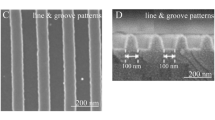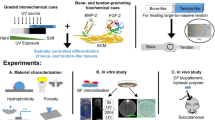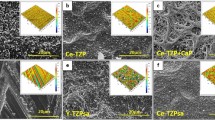Abstract
A key tenet of bone tissue engineering is the development of scaffold materials that can stimulate stem cell differentiation in the absence of chemical treatment to become osteoblasts without compromising material properties. At present, conventional implant materials fail owing to encapsulation by soft tissue, rather than direct bone bonding. Here, we demonstrate the use of nanoscale disorder to stimulate human mesenchymal stem cells (MSCs) to produce bone mineral in vitro, in the absence of osteogenic supplements. This approach has similar efficiency to that of cells cultured with osteogenic media. In addition, the current studies show that topographically treated MSCs have a distinct differentiation profile compared with those treated with osteogenic media, which has implications for cell therapies.
This is a preview of subscription content, access via your institution
Access options
Subscribe to this journal
Receive 12 print issues and online access
$259.00 per year
only $21.58 per issue
Buy this article
- Purchase on SpringerLink
- Instant access to full article PDF
Prices may be subject to local taxes which are calculated during checkout





Similar content being viewed by others
References
Curtis, A. S. G. & Varde, M. Control of cell behaviour: Topological factors. J. Natl Cancer Res. Inst. 33, 15–26 (1964).
Curtis, A. S. G. & Wilkinson, C. D. W. Nanotechniques and approaches in biotechnology. Trends Biotechnol. 19, 97–101 (2001).
Stevens, M. M. & George, J. H. Exploring and engineering the cell surface interface. Science 310, 1135–1138 (2005).
Vieu, C. et al. Electron beam lithography: Resolution limits and applications. Appl. Surf. Sci. 164, 111–117 (2000).
Dalby, M. J. et al. Optimizing HAPEX topography influences osteoblast response. Tissue Eng. 8, 453–467 (2002).
Anselme, K. & Bigerelle, M. Topography effects of pure titanium substrates on human osteoblast long-term adhesion. Acta Biomater. 1, 211–222 (2005).
Castellani, R., de Ruijter, A., Renggli, H. & Jansen, J. Response of rat bone marrow cells to differently roughened titanium discs. Clin. Oral Implants Res. 10, 369–378 (1999).
ter Brugge, P. J., Wolke, J. G. & Jansen, J. A. Effect of calcium phosphate coating crystallinity and implant surface roughness on differentiation of rat bone marrow cells. J. Biomed. Mater. Res. 60, 70–78 (2002).
Ball, P. Life’s lessons in design. Nature 409, 413–416 (2001).
Friedenstein, A. J. Precursor cells of mechanocytes. Int. Rev. Cytol. 47, 327–359 (1976).
Bianco, P. & Robey, P. G. Stem cells in tissue engineering. Nature 414, 118–121 (2001).
Oreffo, R. O. C., Cooper, C., Mason, C. & Clements, M. Mesenchymal stem cells: Lineage, plasticity and skeletal therapeutic potential. Stem Cell Rev. 1, 169–178 (2005).
Lavigne, P., Benderdour, M., Lajeunesse, D., Shi, Q. & Fernandes, J. C. Expression of ICAM-1 by osteoblasts in healthy individuals and in patients suffering from osteoarthritis and osteoporosis. Bone 35, 463–470 (2004).
Boyan, B. D. et al. Osteoblasts generate an osteogenic microenvironment when grown on surfaces with rough microtopographies. Eur. Cell. Mater. 6, 22–7 (2003).
Zinger, O. et al. Differential regulation of osteoblasts by substrate microstructural features. Biomaterials 26, 1837–1847 (2005).
Diehn, M. et al. SOURCE: A unified genomic resource of functional annotations, ontologies, and gene expression data. Nucleic Acids Res. 31, 219–223 (2003).
Wilkie, A. O. Bad bones, absent smell, selfish testes: The pleiotropic consequences of human FGF receptor mutations. Cytokine Growth Factor Rev. 16, 187–203 (2005).
Miettinen, P. J. et al. Epidermal growth factor receptor function is necessary for normal craniofacial development and palate closure. Nature Genet. 22, 69–73 (1999).
Sallusto, F. & Mackay, C. R. Chemoattractants and their receptors in homeostasis and inflammation. Curr. Opin. Immunol. 16, 724–731 (2004).
Zayzafoon, M. Calcium/calmodulin signaling controls osteoblast growth and differentiation. J. Cell. Biochem. 97, 56–70 (2006).
Leven, R. M., Virdi, A. S. & Sumner, D. R. Patterns of gene expression in rat bone marrow stromal cells cultured on titanium alloy discs of different roughness. J. Biomed. Mater. Res. A 70, 391–401 (2004).
Stein, G. S. & Lian, J. B. Molecular mechanisms mediating proliferation/differentiation interrelationships during progressive development of the osteoblast phenotype. Endocr. Rev. 14, 424–442 (1993).
Huang, Y. C., Kaigler, D., Rice, K. G., Krebsbach, P. H. & Mooney, D. J. Combined angiogenic and osteogenic factor delivery enhances bone marrow stromal cell-driven bone regeneration. J. Bone Miner. Res. 20, 848–857 (2005).
Huang, Y. C., Simmons, C., Kaigler, D., Rice, K. G. & Mooney, D. J. Bone regeneration in a rat cranial defect with delivery of PEI-condensed plasmid DNA encoding for bone morphogenetic protein-4 (BMP-4). Gene Ther. 12, 418–426 (2005).
McBeath, R., Pirone, D. M., Nelson, C. M., Bhadriraju, K. & Chen, C. S. Cell shape, cytoskeletal tension, and RhoA regulate stem cell lineage commitment. Dev. Cell. 6, 483–495 (2004).
Engler, A. J. et al. Myotubes differentiate optimally on substrates with tissue-like stiffness: Pathological implications for soft or stiff microenvironments. J. Cell Biol. 166, 877–887 (2004).
Engler, A. J., Sen, S., Sweeney, H. L. & Discher, D. E. Matrix elasticity directs stem cell lineage specification. Cell 126, 677–689 (2006).
Curtis, A., Sokolikova-Csaderova, L. & Aitchison, G. Measuring cell forces by a photoelastic method. Biophys J. 92, 2255–2261 (2007).
Dalby, M. J. et al. Nanotopographical stimulation of mechanotransduction and changes in interphase centromere positioning. J. Cell. Biochem. 100, 326–338 (2007).
Chen, C. S., Mrksich, M., Huang, S., Whitesides, G. M. & Ingber, D. E. Geometric control of cell life and death. Science 276, 1425–1428 (1997).
Aroush, D. R.-B. & Wagner, H. D. Shear-stress profile along a cell focal adhesion. Adv. Mater. 18, 1537–1540 (2006).
Dalby, M. J. et al. Nanomechanotransduction and interphase nuclear organisation influence on genomic control. J. Cell. Biochem. (in the press).
Dalby, M. J., Riehle, M. O., Johnstone, H., Affrossman, S. & Curtis, A. S. In vitro reaction of endothelial cells to polymer demixed nanotopography. Biomaterials 23, 2945–2954 (2002).
Dalby, M. J., Gadegaard, N., Riehle, M. O., Wilkinson, C. D. & Curtis, A. S. Investigating filopodia sensing using arrays of defined nano-pits down to 35 nm diameter in size. Int. J. Biochem. Cell. Biol. 36, 2015–2025 (2004).
Dalby, M. J., Gadegaard, N. & Wilkinson, C. D. W. The response of fibroblasts to hexagonal nanotopography fabricated by electron beam lithograhy. J. Biomed. Mater. Res. A (2007, in the press).
Gadegaard, N., Mosler, S. & Larsen, N. B. Biomimetic polymer nanostructures by injection moulding. Macromol. Mater. Eng. 288, 76–83 (2003).
Lister, K. A. et al. Direct imprint of sub-10 nm features into metal using diamond and SiC stamps. J. Vac. Sci. Technol. B 22, 3257–3259 (2004).
Gadegaard, N. et al. Arrays of nano-dots for cellular engineering. Microelectron. Eng. 67–68, 162–168 (2003).
Yang, X. et al. Induction of human osteoprogenitor chemotaxis, proliferation, differentiation, and bone formation by osteoblast stimulating factor-1/pleiotrophin: Osteoconductive biomimetic scaffolds for tissue engineering. J. Bone Miner. Res. 18, 47–57 (2003).
Howard, D. et al. Immunoselection and adenoviral genetic modulation of human osteoprogenitors: In vivo bone formation on PLA scaffold. Biochem. Biophys. Res. Commun. 299, 208–215 (2002).
Mirmalek-Sani, S. H. et al. Characterization and multipotentiality of human fetal femur-derived cells—implications for skeletal tissue regeneration. Stem Cells 24, 1042–1053 (2006).
Dalby, M. J. et al. Attempted endocytosis of nano-environment produced by colloidal lithography by human fibroblasts. Exp. Cell. Res. 295, 387–394 (2004).
Dalby, M. J., Riehle, M. O., Yarwood, S. J., Wilkinson, C. D. & Curtis, A. S. Nucleus alignment and cell signaling in fibroblasts: Response to a micro-grooved topography. Exp. Cell. Res. 284, 274–282 (2003).
Breitling, R., Armengaud, P., Amtmann, A. & Herzyk, P. Rank products: A simple, yet powerful, new method to detect differentially regulated genes in replicated microarray experiments. FEBS Lett. 573, 83–92 (2004).
Acknowledgements
M.J.D. is a BBSRC David Phillips Fellow, N.G. is an RSE Fellow, R.T. is supported by the BBSRC and ROCO is supported by grants from the BBSRC and EPSRC. We thank A. Curtis for discussions.
Author information
Authors and Affiliations
Contributions
M.J.D. designed and carried out many of the experiments, analysed most of the data and wrote much of the original manuscript and rewrites. N.G. designed and fabricated the materials and helped with manuscript style/writing and electronics sections. R.T. isolated stem cells, carried out PCR and analysed the PCR data. A.A. carried out the microarray experiments. M.O.R. helped in experimental and material design. P.H. helped M.J.D. with bioinformatics analysis and data presentation. C.D.W. was involved in material design and facilitation of fabrication. R.O.C.O. facilitated stem cell isolation and PCR, helped M.J.D. and R.T. with experimental design and wrote much of the original manuscript and rewrites.
Corresponding author
Supplementary information
Supplementary Information
Supplementary figures, tables, methods and references (PDF 3108 kb)
Rights and permissions
About this article
Cite this article
Dalby, M., Gadegaard, N., Tare, R. et al. The control of human mesenchymal cell differentiation using nanoscale symmetry and disorder. Nature Mater 6, 997–1003 (2007). https://doi.org/10.1038/nmat2013
Received:
Accepted:
Published:
Issue Date:
DOI: https://doi.org/10.1038/nmat2013
This article is cited by
-
Mesenchymal stem cells osteogenic differentiation by ZnO nanoparticles and polyurethane bimodal foam nanocomposites
Cell and Tissue Banking (2024)
-
Potential of Nano-Engineered Stem Cells in the Treatment of Multiple Sclerosis: A Comprehensive Review
Cellular and Molecular Neurobiology (2024)
-
Biomechanical, biophysical and biochemical modulators of cytoskeletal remodelling and emergent stem cell lineage commitment
Communications Biology (2023)
-
Nanotopography reveals metabolites that maintain the immunomodulatory phenotype of mesenchymal stromal cells
Nature Communications (2023)
-
Crosslinking strategies for biomimetic hydrogels in bone tissue engineering
Biophysical Reviews (2023)




